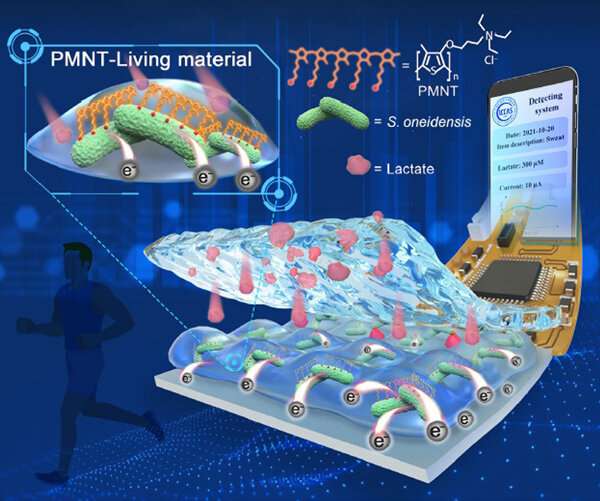Flexible bioelectronic device based on living material for monitoring lactate and tumor cells

The demand for real-time health monitoring is growing. A research team from the Institute of Chemistry of the Chinese Academy of Sciences (ICCAS) recently developed a living material for real-time monitoring of lactate, a biomarker for cancer.
Lactate is a major analyte in bioprocess engineering, sports medicine and clinical care, and it is also a reliable biomarker of tumor generation, metastasis and recurrence. Portable biosensors with good performance for monitoring the lactate content in body fluids are in demand.
Living materials are a new type of biohybrid material consisting of living elements (bacteria, mammalian cells, fungi and algae, etc.) and artificial functional materials. Benefiting from the combination of their respective advantages, living materials are used for biosensing, biosynthesis, and biomedical diagnosis. Conjugated polymers (CPs) are characterized by a delocalized electronic structure that allows electron transfer.
By further modification of the CP backbone using water-soluble side chains, a series of novel water-soluble conjugated polymers (WSCPs) were designed and synthesized with excellent water-solubility, photoelectric property and biocompatibility. WSCPs are expected to be good artificial functional materials for constructing living materials and bioelectronic devices.
Led by Prof. Wang Shu and Prof. Bai Haotian, the ICCAS team constructed a living material with cationic polythiophene (PMNT) and Shewanella oneidensis MR-1. The PMNT could contribute to the biofilm formation and optimize bioelectronic process inside S. oneidensis MR-1; thus, the constructed living materials could accelerate the oxidization process from lactate and enhance the outward electron transfer rate.
The material was then used to fabricate a flexible bioelectronic device for lactate detection in physiological fluids (sweat, urine and plasma) and tumor cells through further functional module integration and engineering technology processing. All the collected electrical signals gathered by the flexible bioelectronic device could be wirelessly transferred to a portable smartphone for reading and analyzing.
This work provides a new strategy for integrating the biological activity of living cells and the optoelectronic properties of CPs for preparing living materials. The flexible and wearable electronic devices based on the new living materials have potential applications for personal health monitoring in the future.
The study was published in Science Advances.
More information: Zenghao Wang et al, Flexible bioelectronic device fabricated by conductive polymer–based living material, Science Advances (2022). DOI: 10.1126/sciadv.abo1458
Journal information: Science Advances
Provided by Chinese Academy of Sciences





















